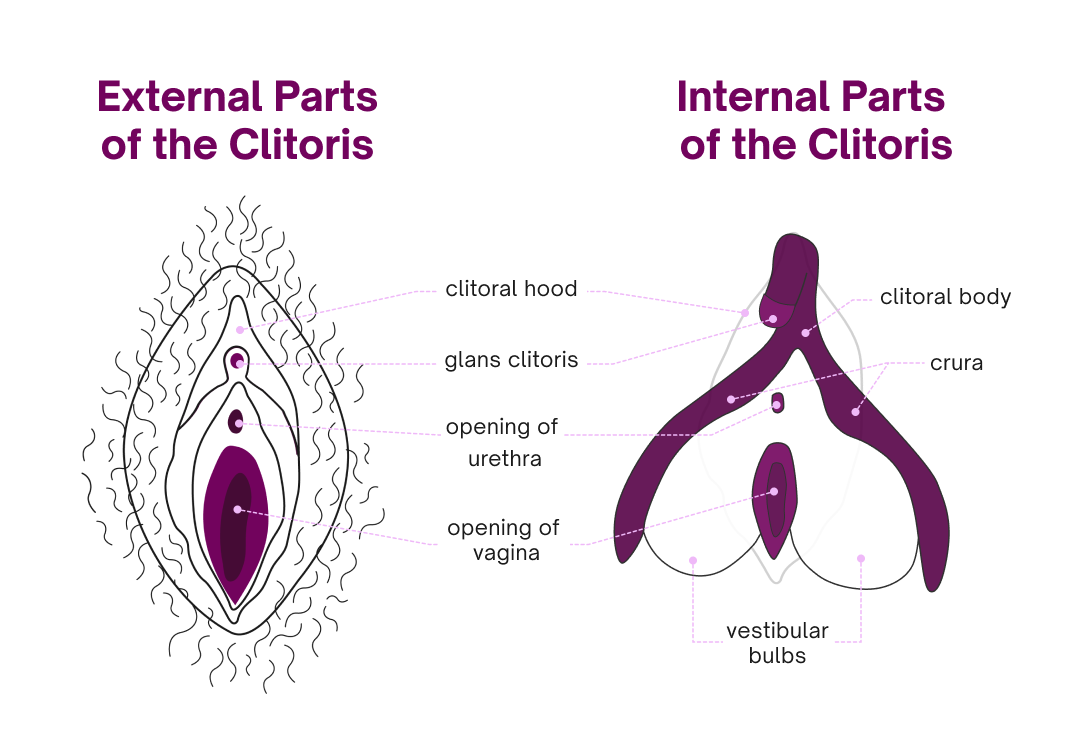Clitoris: Where is it, diagram & anatomy explained
Key Takeaways
- The clitoris is an important sexual organ that’s comprised of several internal and external parts
- A very small part of the clitoris is visible on the vulva, but most of the clitoris is located internally
- Stimulating the clitoris can lead to orgasm, and research has shown clitoral stimulation to be more effective at reaching climax than vaginal stimulation on its own
On this page
- What is a clitoris?
- Where is the clitoris?
- How to stimulate the clitoris
- Facts about the clitoris
- 1. A clitoris can be as long as 5 inches
- 2. The clitoris gets bigger when aroused
- 3. The clitoris is purely for pleasure
- 4. The clitoris is behind most female orgasms
- 5. The clitoris can help with pain relief
- 6. It’s structures and functions weren’t clear until the 1990s
- Get to know your body better with Natural Cycles
This article is also available in Spanish.
What is a clitoris?
The clitoris is a female sex organ and the most erogenous (feel-good) part of the vulva. Unlike other parts of the female reproductive system, such as the uterus or the vagina, it doesn’t serve any direct reproductive purpose. Instead, its main role seems to be making sex enjoyable.
Historically, this part of the pleasure anatomy has been misunderstood or simply overlooked entirely, but recent research into this organ has revealed some exciting new info about female sexual pleasure.
Where is the clitoris?
The clitoris is visible on your vulva, just above the vaginal opening. The visible part, that's about the size of a pea, is only a small part of the clitoris. The majority of your clitoris isn’t visible. It sits under your skin and attaches to your pelvic bone via ligaments (a stretchy type of tissue).
What are the external parts of the clitoris?
The part of the clitoris that you can see on the vulva is known as the glans clitoris (or the head of the clitoris). It’s very small, but it’s also the most sensitive part of the clitoris. The glans clitoris is protected by two skin folds known as the clitoral hood. Unlike the internal part of the clitoris, the glans clitoris does not swell or change shape during sexual arousal.
What are the internal parts of the clitoris?
The internal parts of the clitoris are significantly larger and are not visible on the vulva itself. The clitoral body sits just below the surface and is attached directly to the glans clitoris. The body of the clitoris is also joined to what is called the ‘crura.’ These look a little bit like legs. The clitoris branches into the shape of an upside-down heart around the urethral and vaginal openings. These heart-shaped parts are known as the vestibular bulbs.
Both the bulbs and crura of the clitoris contain erectile tissue that fills with blood and swells up during sexual arousal. The arousal and swelling of the clitoris can also increase lubrication and increase sensitivity during sexual activity.

How to stimulate the clitoris
- Get to know your vulva: It’s important to familiarize yourself with your own anatomy before you dive right in. Check out how to do a vagina self-exam and get to know the landscape of your vulva, this will help you understand the clitoris better.
- Start gently: You want to start out this process feeling relaxed and at ease. There’s no need to rush straight into things. Begin by touching the area around the clitoris. For some people, the clitoris is so sensitive that this level of stimulation will be enough to reach arousal. You can also try gently touching or stroking the head of the clitoris itself.
- Use lubrication: You may find using a lubricant makes clitorial stimulation more enjoyable as it can reduce friction and prevent dryness in the area.
- Try different things: Everyone’s preferences are different. Experiment with types of touch, introducing sex toys, or involving a partner. You can also see how it feels to put fingers, sex toys, or a penis inside the vagina and stimulate the clitoris from within.
Facts about the clitoris
Now you’ve learned all about the anatomy of the clitoris, let’s take a look at some of the facts that show just how incredible this organ really is!
1. A clitoris can be as long as 5 inches
From the outside, the clitoris might look small, but the bit you can see is just the tip of the iceberg. Most of the clitoris is internal and isn’t visible. The bit of the clitoris that can be seen is only about a centimeter in diameter. However, in total, the clitoris can be as long as 5 inches (12 cm) long! While we’re on the subject of size, did you know that in early fetal development, the penis and the clitoris actually start out the same? They form into the different sexual organs around the eleventh week of pregnancy.
2. The clitoris gets bigger when aroused
Just like the penis, when aroused, blood rushes to the clitoris, causing it to swell and become erect. This increased blood flow also causes the rest of the vulva to deepen in color. The clitoris isn’t the only part of the vulva that changes when aroused. The vagina also widens and deepens.
3. The clitoris is purely for pleasure
There are a few theories behind the evolutionary purpose of the clitoris, but when it comes down to it, it doesn’t play a direct role in human reproduction. It’s just there to make us feel good! We think that’s pretty cool, but humans aren’t alone in finding sex enjoyable—many more mammals like to do it, too. A recent study found there are some striking similarities between the human and dolphin clitoris…and just like it is for us, its main purpose seems to be for pleasure.
4. The clitoris is behind most female orgasms
A recent study found that a mere 18% of women can reach orgasm through only having penetrative vaginal sex. When you think of how we learn about sex and how it’s portrayed in films and on TV, that’s quite a startling statistic. The female orgasm hasn’t been honestly depicted –- it’s perfectly normal to only reach orgasm through clitoral stimulation, and, in fact, most women climax this way. On top of this, there’s even research that suggests that those women who can reach orgasm through penetrative sex can do so because of the placement of the clitoris, meaning it really is the pleasure center!
5. The clitoris can help with pain relief
If you’ve ever felt frisky on your period while experiencing painful cramps, the clitoris may hold the key to your relief. The change in hormone levels that happens at the start of a new cycle can be responsible for increasing libido. So it’s perfectly normal to experience a high sex drive while you’re bleeding; having an orgasm releases endorphins (a type of feel-good hormone) that can reduce period pain. And while we’re on the subject, period sex or masturbating on your period are both totally safe and healthy things to do!
6. It’s structures and functions weren’t clear until the 1990s
Perhaps the most mind-boggling fact of all is just how recently the clitoris has gained official recognition. Sexual pleasure has existed as long as people have been having sex. Still, centuries of stigma and a lack of research into female health meant that we’ve started to understand the clitoris from a medical perspective only in recent history. We have an Australian urologist, Helen O’Connell, to thank for her work in the MRI scanning (and later 3D modeling) of the clitoris. This research has helped us learn more about the anatomy of this amazing organ and we can now fully begin to understand and recognize just how incredible it is.
Get to know your body better with Natural Cycles
We hope you enjoyed reading up on the fascinating clitoris! At Natural Cycles, we’re passionate about empowering you with knowledge about your body while supporting you on your own fertility journey.
Natural Cycles is the first birth control app to be FDA Cleared as a certified medical device. If you’re looking for a natural way to prevent pregnancy, why not find out if the Natural Cycles app could work for you? It’s 100% hormone-free and is packed full of useful content that’s tailored towards you and your fertility journey.
Did you enjoy reading this article?
